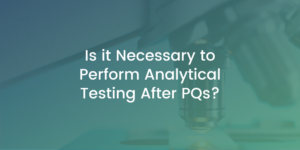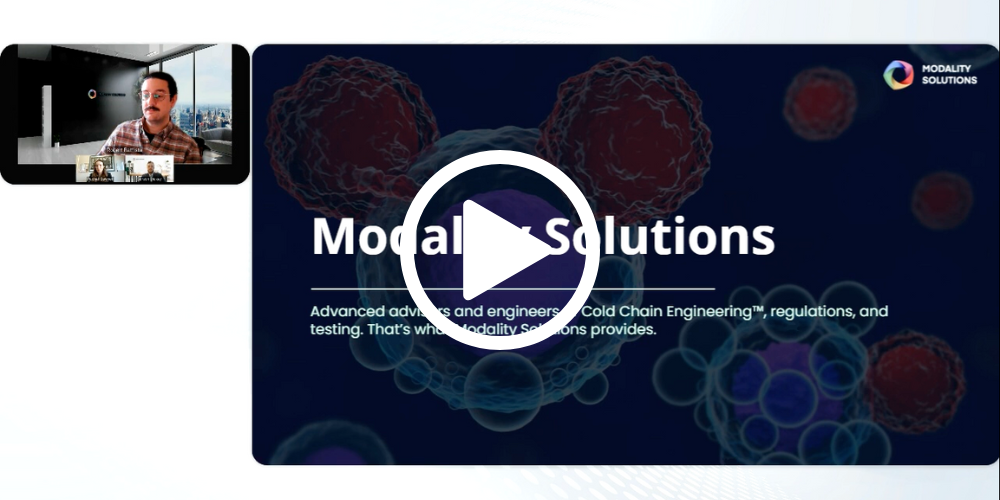Part 2: Expanding Shipping Temperatures Without Sacrificing Quality: A Guide to Transport Validation and PQ
Demonstrating Product Quality All pharmaceutical manufacturers must ensure that the safety and efficacy of...
read Details

Executive Summary:
As clients choose Modality Solutions as their trusted cold chain consultants and engineering experts, it’s common to question why we don’t recommend analytical testing after performance qualification. In this blog, we describe why analytical testing after the Performance Qualifications (PQs) is unnecessary and why we don’t include it in our performance qualification protocols. We discuss:
10-15 years ago, pharmaceutical, biologics, and medical device companies didn’t have access to the transport simulation technology we do today (and regulatory agencies didn’t understand transport simulation as a testing method for drug product quality). Real-world shipping studies were necessary to prove that your drug product was safe and efficacious throughout the supply chain.
In transport validation best practices, a product Operational Qualification (OQ) confirms your drug product is viable at the edge of your operating space (against worst-case conditions, at the edge of the failure). Before transport simulation was available, pharma companies would historically design real-world shipment studies to find an upper limit of miles that could be shipped without damaging the product.
Example: For an OQ test, a pharmaceutical company might take their commercial formulation, package it, and ship it 35,000 miles worldwide (farther than any normal shipping process would typically require) using ground and air transport. Once returned, they would perform analytical testing, identifying 35,000 miles as the theoretical maximum limit.
Then, companies move into Performance Qualification (PQ). Unlike OQs, PQs are not designed to test at the edge of your operating space. PQ is the process of confirming representative or actual distribution lanes to verify typical shipping and delivery procedures. Regulatory agencies expect PQs to show you can perform delivery from Point A to Point B multiple times, demonstrating the robustness and repeatability of the process.
Because of how these processes were set up, OQ and PQ were commonly conducted together as a single qualification test, which is no longer an accepted best practice.
As the industry’s best practices progressed, regulatory agencies pursued a more thorough cold chain approach and started following best practices used to validate their manufacturing processes. A transfer of good manufacturing practices (GMP) to the distribution processes (Good Distribution Practices or GDP) was underway. At the same time, transport simulation became an accepted approach (though companies were still performing real-world shipments, too).
Because in earlier practice OQs and PQs were performed concurrently, pharma manufacturers defaulted to analytical testing after PQs in addition to analytical testing after OQs in the new process.
When submitting to regulatory agencies, you add to your burden by conducting analytical testing after PQ. By performing analytical testing after Performance Qualifications, you re-emphasize critical-to-quality attributes you’ve already confirmed during Operational Qualification. Essentially, you’ve proved your drug product is safe and efficacious at the edge of your operating space (in OQ), so you don’t need to prove it again after PQ.
Many companies insist on analytical testing after Performance Qualification because they believe it is a risk-averse approach when actually, you’re putting your timeline at even greater risk. Requiring analytical testing after the PQ can raise doubts regarding the effectiveness of your product OQ. If you are arguing that the OQ is worst-case and demonstrates that the product is robust, conducting analytical testing after PQs is inconsistent with the validation strategy.
Consider this: you’re in school and your teacher has provided a multiple-choice exam with five questions to assess if you’ve understood the lesson. Instead of responding to those five questions and turning in the exam, you add an essay to the end of the test to emphasize your understanding of the chapter. However, upon reading your essay, the teacher determines that you didn’t understand the lesson after all and requires you to retake the exam.
When you perform analytical testing after PQ, this can cause regulatory agencies to enforce shipping time or duration requirements. These requirements remove supply chain flexibility by requiring all shipments to have a shorter duration than the PQ shipment duration. Any shipment delays will require destruction of all product in the shipment, or the quarantine of the product until product quality is demonstrated. This can be an incredibly expensive requirement to adhere to during commercial operations.
Conducting analytical testing after PQs can connect product robustness to specific shipping lanes and thermal packaging. Therefore, any changes to shipping lanes or thermal packaging may require re-execution of the PQs, including analytical testing, to demonstrate the new lane or packaging does not impact the product. Using commercial product for unnecessary analytical testing is costly and limits the amount of product that is available for patients.
When you perform analytical testing after Performance Qualification, there’s a chance your drug product could fail, causing unnecessary financial expense and time delays. From a practical point of view, why open that door when there’s no reason to open it? To top it off, Performance Qualification occurs at the end of the process. Pharma companies who insist on analytical testing after PQs open themselves up to a considerable timeline risk close to the filing date.
If there is an issue with drug product viability after the Performance Qualification, pharma companies will spend significant time and energy explaining why the failure isn’t an issue.
Many pharmaceutical companies believe that regulatory agencies will find it unacceptable to omit analytical testing post-PQ or that leaving it out of the process will open them up to Information Requests. This belief is an outdated perception.
Of the 80+ approvals Modality Solutions has completed in the three years, the regulators accepted transport simulation (with no analytical testing after PQ) in every one of these approvals. A few dozen times, companies received an information request asking why analytical testing after PQs wasn’t performed (even though we used transport simulation). While this can be unnerving, the regulatory agency isn’t telling you that you should have done analytical testing. They’re ensuring you can explain why it was omitted from the process. When Modality Solutions helped clients provide IR responses for why analytical testing wasn’t performed after PQ, responses were accepted without comment 100% of the time.
Whether your modality or therapeutic use, Modality Solutions has the expertise to optimize the cold chain and guide your therapy through the regulatory framework from early development through approval. Our transport simulation testing technology and regulatory experience span the full range of therapeutic modalities and their diverse cold chain requirements. Don’t hesitate to reach out to our team to discuss your cold chain needs.
Demonstrating Product Quality All pharmaceutical manufacturers must ensure that the safety and efficacy of...
read Details
Introduction The integrity of supply chain management is pivotal in the demanding realm of...
read Details
Entering the U.S. market comes with a unique set of regulatory challenges, particularly when...
read Details